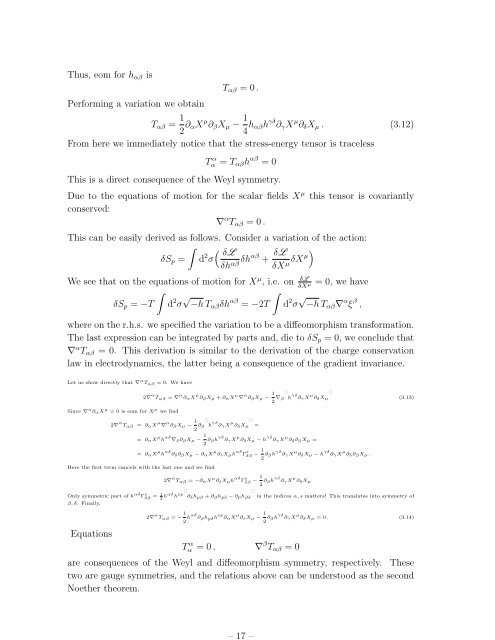Lectures on String Theory
Lectures on String Theory
Lectures on String Theory
Create successful ePaper yourself
Turn your PDF publications into a flip-book with our unique Google optimized e-Paper software.
– 17 –<br />
Thus, eom for h αβ is<br />
Performing a variati<strong>on</strong> we obtain<br />
T αβ = 0 .<br />
T αβ = 1 2 ∂ αX µ ∂ β X µ − 1 4 h αβh γδ ∂ γ X µ ∂ δ X µ . (3.12)<br />
From here we immediately notice that the stress-energy tensor is traceless<br />
T α α = T αβ h αβ = 0<br />
This is a direct c<strong>on</strong>sequence of the Weyl symmetry.<br />
Due to the equati<strong>on</strong>s of moti<strong>on</strong> for the scalar fields X µ this tensor is covariantly<br />
c<strong>on</strong>served:<br />
∇ α T αβ = 0 .<br />
This can be easily derived as follows. C<strong>on</strong>sider a variati<strong>on</strong> of the acti<strong>on</strong>:<br />
∫ ( δL<br />
δS p = d 2 σ<br />
δh αβ δhαβ + δL )<br />
δX µ δXµ<br />
We see that <strong>on</strong> the equati<strong>on</strong>s of moti<strong>on</strong> for X µ , i.e. <strong>on</strong> δL = 0, we have<br />
δX<br />
∫<br />
µ<br />
δS p = −T d 2 σ √ ∫<br />
−h T αβ δh αβ = −2T d 2 σ √ −h T αβ ∇ α ξ β ,<br />
where <strong>on</strong> the r.h.s. we specified the variati<strong>on</strong> to be a diffeomorphism transformati<strong>on</strong>.<br />
The last expressi<strong>on</strong> can be integrated by parts and, die to δS p = 0, we c<strong>on</strong>clude that<br />
∇ α T αβ = 0. This derivati<strong>on</strong> is similar to the derivati<strong>on</strong> of the charge c<strong>on</strong>servati<strong>on</strong><br />
law in electrodynamics, the latter being a c<strong>on</strong>sequence of the gradient invariance.<br />
Let us show directly that ∇ α T αβ = 0. We have<br />
2∇ α T αβ = ∇ α ∂ α X µ ∂ β X µ + ∂ α X µ ∇ α ∂ β X µ − 1 2 ∇ β<br />
h γδ ∂ γ X µ ∂ δ X µ<br />
<br />
(3.13)<br />
Since ∇ α ∂ αX µ = 0 is eom for X µ we find<br />
2∇ α T αβ<br />
= ∂ α X µ ∇ α ∂ β X µ − 1 2 ∂ β<br />
h γδ ∂ γ X µ ∂ δ X µ<br />
<br />
=<br />
= ∂ αX µ h αδ ∇ δ ∂ β X µ − 1 2 ∂ β h γδ ∂ γ X µ ∂ δ X µ − h γδ ∂ γ X µ ∂ δ ∂ β X µ =<br />
= ∂ αX µ h αδ ∂ δ ∂ β X µ − ∂ αX µ ∂ sX µh αδ Γ s δβ − 1 2 ∂ β h γδ ∂ γ X µ ∂ δ X µ − h γδ ∂ γ X µ ∂ δ ∂ β X µ .<br />
Here the first term cancels with the last <strong>on</strong>e and we find<br />
2∇ α T αβ = −∂ α X µ ∂ s X µ h αδ Γ s δβ − 1 2 ∂ β h γδ ∂ γ X µ ∂ δ X µ<br />
Only symmetric part of h αδ Γ s δβ = 1 2 hαδ h sp ∂ δ h pβ + ∂ β h pδ − ∂ p h βδ<br />
<br />
in the indices α, s matters! This translates into symmetry of<br />
β, δ. Finally,<br />
Equati<strong>on</strong>s<br />
2∇ α T αβ = − 1 2 hαδ ∂ β h pδ h sp ∂ αX µ ∂ sX µ − 1 2 ∂ β h γδ ∂ γ X µ ∂ δ X µ = 0 . (3.14)<br />
T α α = 0 , ∇ β T αβ = 0<br />
are c<strong>on</strong>sequences of the Weyl and diffeomorphism symmetry, respectively. These<br />
two are gauge symmetries, and the relati<strong>on</strong>s above can be understood as the sec<strong>on</strong>d<br />
Noether theorem.

















